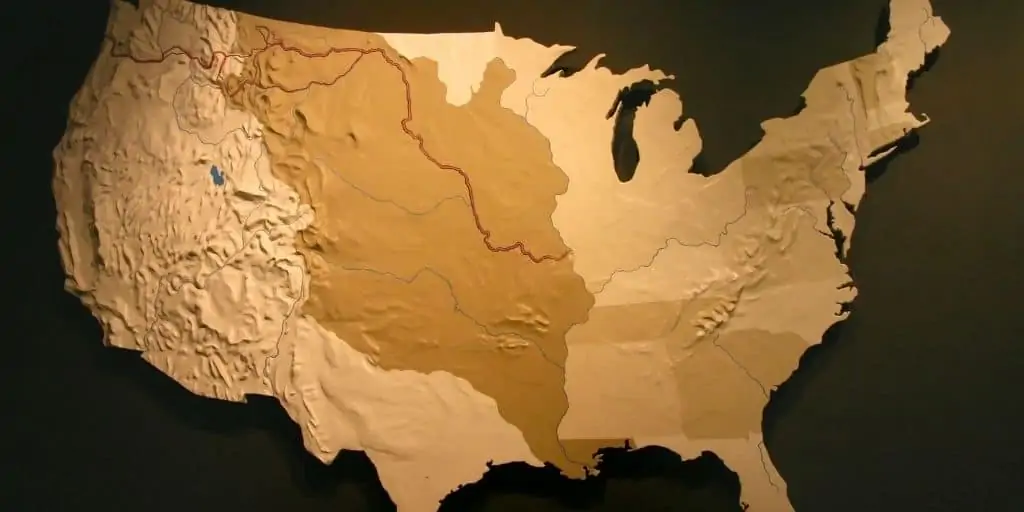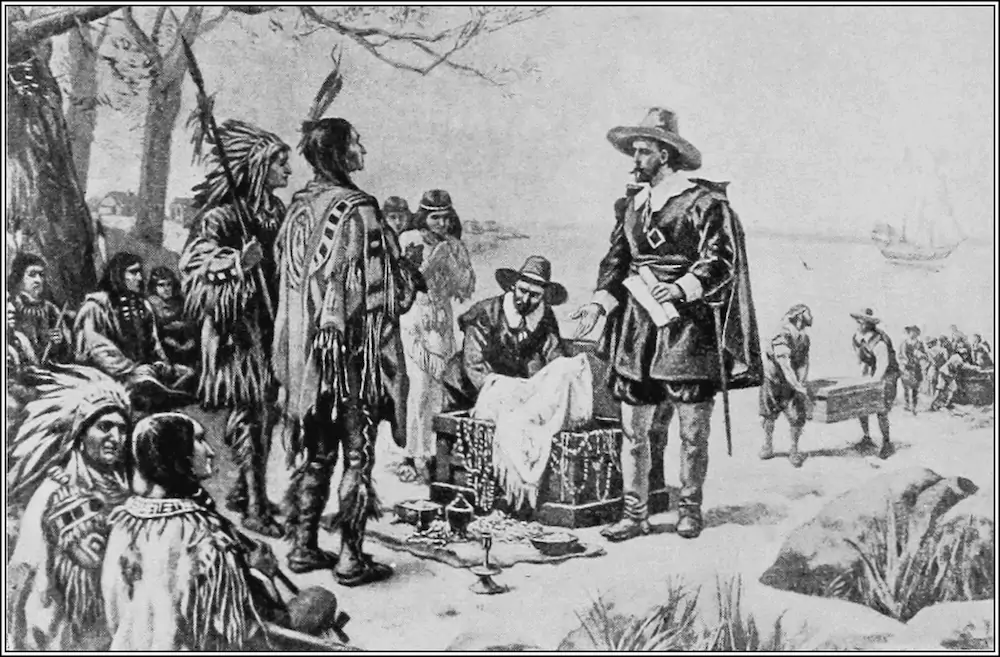Think you know what a great real estate deal looks like? Chances are, you've never seen a deal on this scale before.
In this blog post, you're going to learn about 12 of the greatest real estate deals in recorded history.
1. Louisiana Purchase
In 1803, Napoleon Bonaparte had conquered most of Europe, which was a very expensive ordeal. His next plan was to invade Britain, which would also consume large financial resources.
His answer to the problem was to sell off the territory of Louisiana, which he had acquired from Spain in 1800, with the original intent of reestablishing an extended colonial empire in the West Indies and the Mississippi Valley. However, with his plan to invade Britain, this territory in North America didn’t seem to offer much and was half a world away. It also helped that the United States was a young nation and was happy to buy.
When representatives from the U.S. went to Paris, they assumed only New Orleans and the surrounding parishes were for sale, but when they learned that Bonaparte was looking to sell the entire Mississippi basin, U.S. President Jefferson jumped at the opportunity.
Boneparte received $15 million for the sale (when adjusted for inflation, this is about $349 million USD in today’s values) and America doubled in size overnight.
2. The Alaska Purchase
In the first half of the 18th century, Russia had established a presence in North America, but few Russians actually lived in Alaska. After being badly defeated in the Crimean War, Russian Tzar Alexander II acknowledged that it would be a huge challenge to defend Alaska in any future conflicts.
In 1867, soon after the American Civil War ended, William Seward (U.S. Secretary of State) negotiated with Eduard de Stoeckl (Russian minister) for the purchase of Alaska from the Russian Empire. The treaty was signed on March 30, 1867, and the U.S. Senate ratified it shortly thereafter by a wide margin.
The purchase price was $7.2 million (roughly 2 cents per acre) and with this acquisition, the United States added another 586,412 square miles (1,518,800 km2) to its territory. In modern terms, the cost was equivalent to roughly $128 million USD in 2021 dollars or $0.36 per acre.
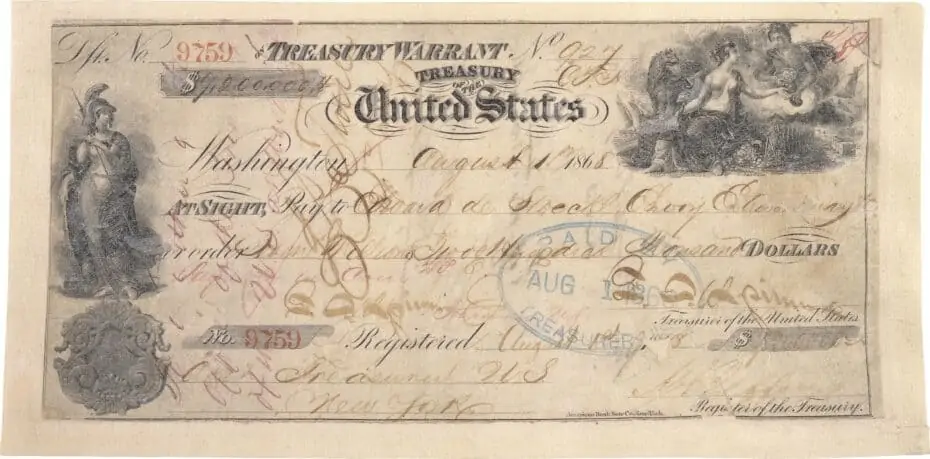
With this check, the United States completed the purchase of almost 600,000 square miles of land from the Russian government.
3. Hong Kong
After Chinese authorities contradicted Britain’s opium trade, the First Opium War between Britain and China began in 1839. The war ended in a decisive loss for China, which resulted in heavy casualties for the Chinese.
To make peace, China decided to cede Hong Kong Island—which was mostly made up of fishing villages that weren't worth much—to Britain in 1842. This was confirmed with the finalization of the Treaty of Nanking. The Kowloon peninsula followed suit in 1860 right after a second Opium War, and Britain expanded its reach northwards into the New Territories in 1898, leasing the region for 99 years.

Capture of Chusan, a sketch by Lt. White, Royal Marines.
Under British rule, this tiny region on the southern coast of China became an economic success. Over the next 80 years, the tiny colony on the southern coast of China grew to become one of the world’s most important trading posts and a global financial center, boasting one of the world’s busiest harbors.
Hong Kong was under British governance until July 1, 1997 when the lease on the New Territories expired. China then resumed the exercise of sovereignty over Hong Kong, ending over 150 years of British colonial rule.
While this wasn't a technical “acquisition” by Britain, it was a long-term lease that came at no cost to the British.
4. Treaty of Tordesillas
Long before “real estate deals” were a thing as we know them today, nations were already doing massive land negotiations of their own.
When Christopher Columbus discovered New World territories in the late 1400s, two international superpowers—Spain and Portugal—had to decide which territories belonged to them.
The monarchs of both countries could not reach a proper settlement, so before war broke out, Spanish rulers enlisted the support of Pope Alexander VI to help them end the conflict in 1493.
The pro-Spain papal pronouncement, however, was not received well by Portuguese rulers, ending in more demanding negotiations with the Spanish monarchs. Seeing that they were somewhat at a disadvantage due to Portugal’s superior military power, Spain relented and agreed on setting a new point of demarcation that would split the new land into two separate territories.
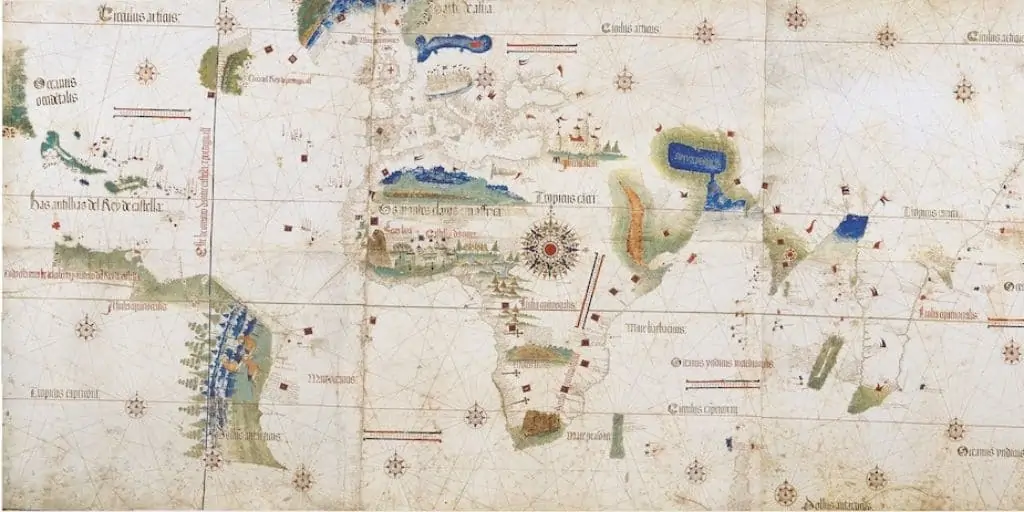
Cantino planisphere showing the meridian in 1502
Both parties met at Tordesillas one year later to finalize their negotiations. The result was a revised north-to-south line, moving to 370 leagues west of Cape Verde Islands. This enabled Portugal to claim the entirety of Brazil, and Spain to gain rights to lands spanning from Chile to North America—and the first known international treaty of modern times.
5. Treaty of Paris
The Treaty of Paris was a classic example of how large quantities of land were transferred from one nation to another in the aftermath of a major war.
After the Siege of Yorktown, Great Britain’s King George III knew his country may not be able to win the Revolutionary War, but he still did not want to give Americans their much-awaited independence. American representatives John Adams, John Jay, and Benjamin Franklin were sent to Great Britain to work out the terms of the peace treaty. Their proposal was simple: Give them independence and they will sign the treaty to end the war.
It took time to come to an agreement; they had to make sure everyone who had fought on the side of the Americans—the French, the Spanish, and the Dutch—received proper consideration as well.
Finally, in September 1783, the Treaty of Paris was ratified, ending the war and restoring the lands conquered by Great Britain to their original owners. The best part? The British monarch ceded most of its territory east of the Mississippi River to the Americans—expanding the size of the new nation in an instant.

Source: Kmusser – Map of the United States and territories after the Treaty of Paris
6. Purchase of Manhattan Island
Many consider the purchase of Manhattan Island the most confusing “real estate deal” in history, and for good reason.
In 1626, the Dutch West India Company (DWIC) received a letter that says:
“They have purchased the Island of Manhattes from the savages for the value of 60 guilders.”
The letter referred to the group headed by Peter Minuit, a savvy Belgian trader who was working for the DWIC. While the transcript states that Minuit bought the island for 60 guilders (worth approximately $1,143 in 2020 U.S. dollars), the exact amount varies by source.
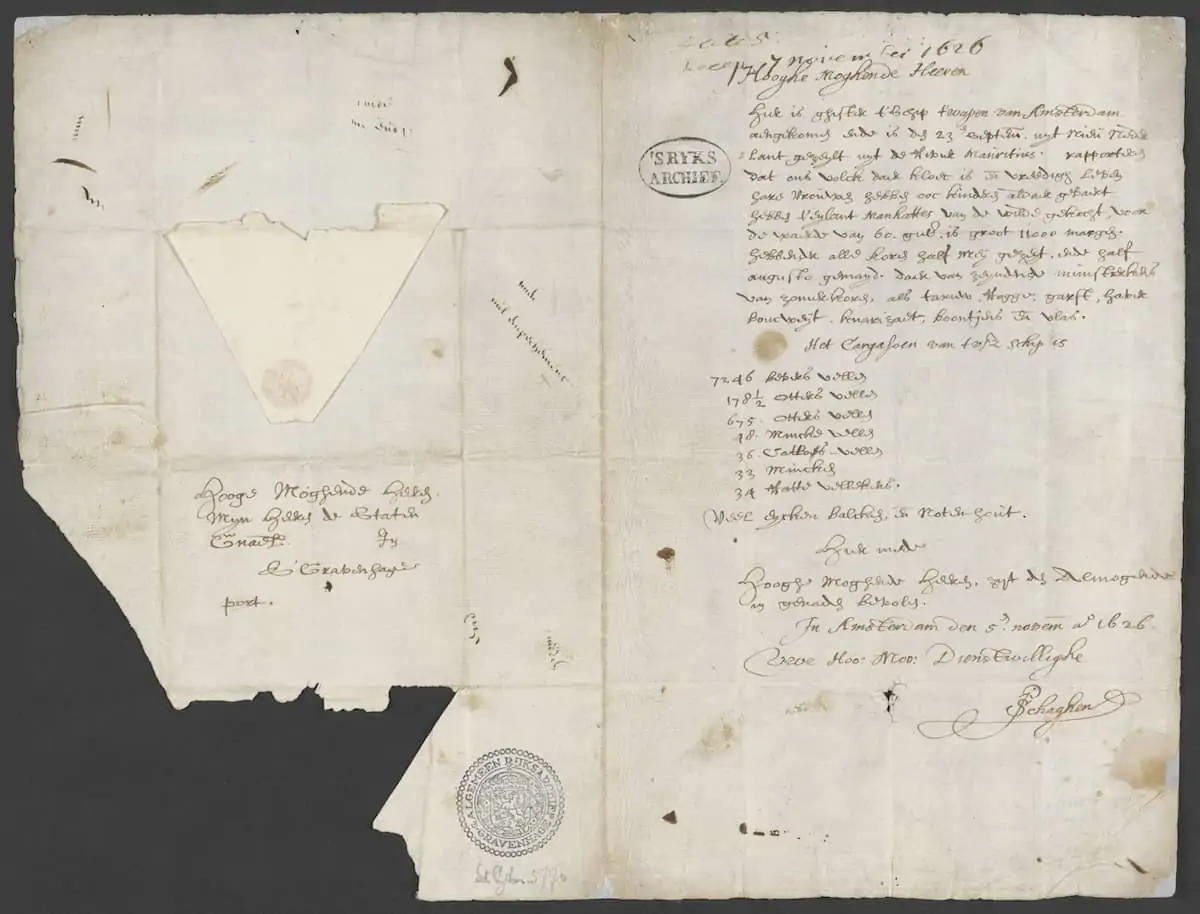
1626 letter by Pieter Schaghen stating (in Dutch) the purchase of Manhattan for 60 guilders.
Most people claim it was purchased for $24 worth of trinkets, while others say the Native Americans were simply offered beads and other goods.
But the confusion is not over the amount the “savages” were paid; it is the agreement both parties thought they had made. While Minuit believed they were agreeing on the purchase, the natives were actually engaging in a type of gift-giving ceremony that signified a reciprocal act of respect.
In the end, it was a case of misunderstanding. The natives did not intend for the Dutch to own Manhattan, as over 30 years later, they still lived on the island.
7. The Treaty of Ghent
While the American and British forces clashed in Chalmette, Louisiana during the War of 1812, representatives from both countries were in Ghent, Belgium to work out a treaty that would end the conflict.
Impressment of seamen, which was one of the main reasons the United States had gone into war, halted after Napoleon’s defeat in 1814, along with the restrictions on American shipping. Britain’s major demand was to create an Indian buffer state, but the United States strongly declined such a provision.
Ultimately, the two nations agreed to a status quo ante bellum, or a restoration of the lands as they existed prior to the war. The Treaty of Ghent, signed on December 24, 1814, was ratified by the British parliament on December 30th. However, it took almost two months for the United States to receive a copy of the treaty due to poor communication. The U.S. Senate then ratified it on February 16, 1815, officially ending the war.
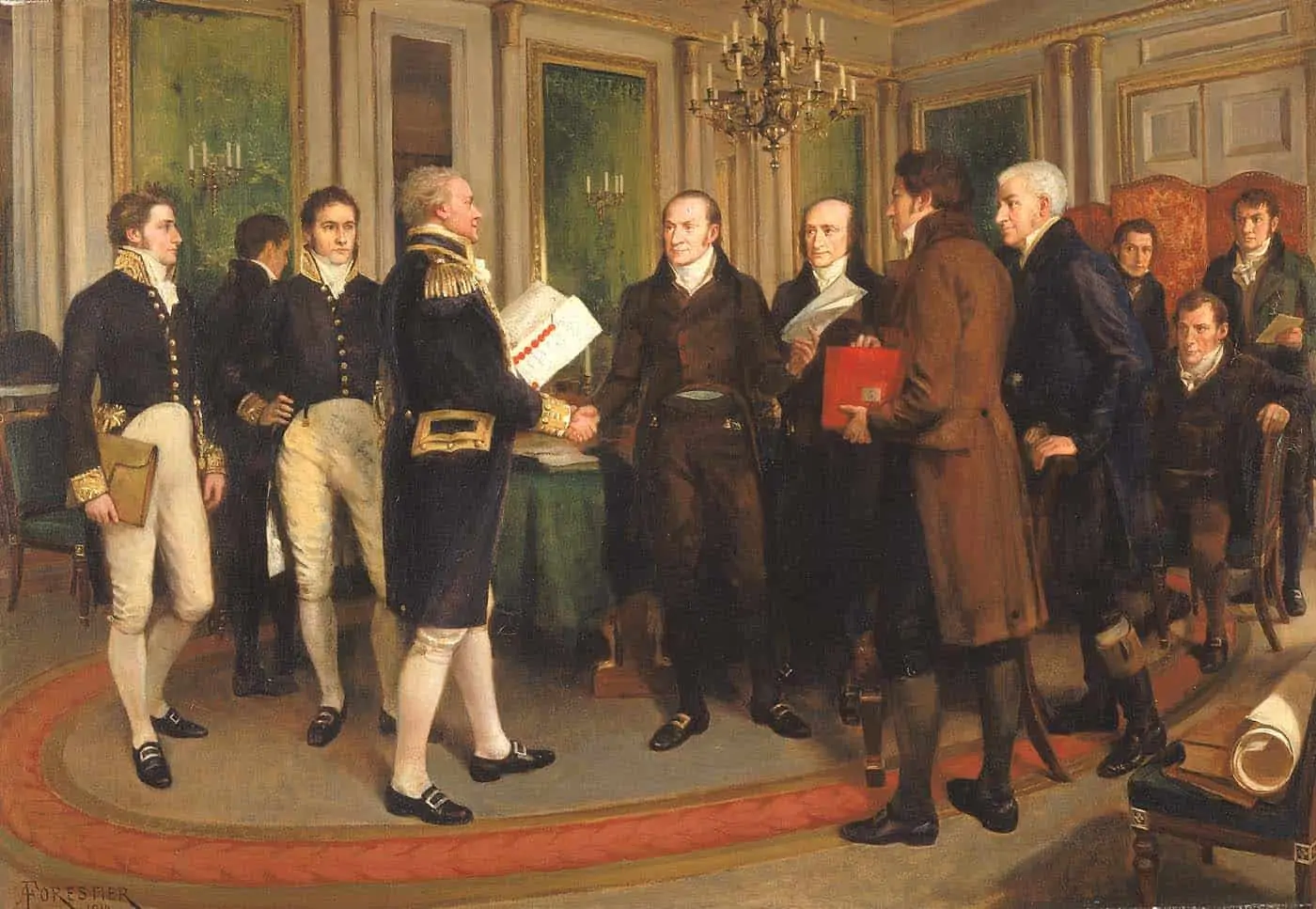
Signing of Treaty of Ghent (1814)
After signing the treaty, all conquered territory was to be returned, and commissions were planned to settle the boundary of the United States and Canada (source). With everything back to normalcy, settlement of the former Northwest territory could proceed, resulting in statehood for Indiana, Illinois, Michigan, Wisconsin, and Minnesota.
8. The Treaty of Guadalupe Hidalgo
When Mexico got independence from Spain in 1821, Texas was originally part of Mexico. However, with growing disputes with the Mexican government due to settlement issues, Texas soon separated itself and asked to become a state of the United States instead. This led to tensions between the two countries.
War broke out between Mexico and the United States in 1846, which the United States won after more than two years.
The Treaty of Guadalupe Hidalgo, signed on February 2, 1848, ended the Mexican-American War. Under this agreement, the Mexican government recognized the Rio Grande as the southern boundary with the United States. They also surrendered a vast tract of land — over 525,000 square miles — to the Americans for a payment of $15 million (which is about $499 million USD in today’s values). This area now covers modern-day Arizona, California, western Colorado, Nevada, New Mexico, Texas, and Utah.
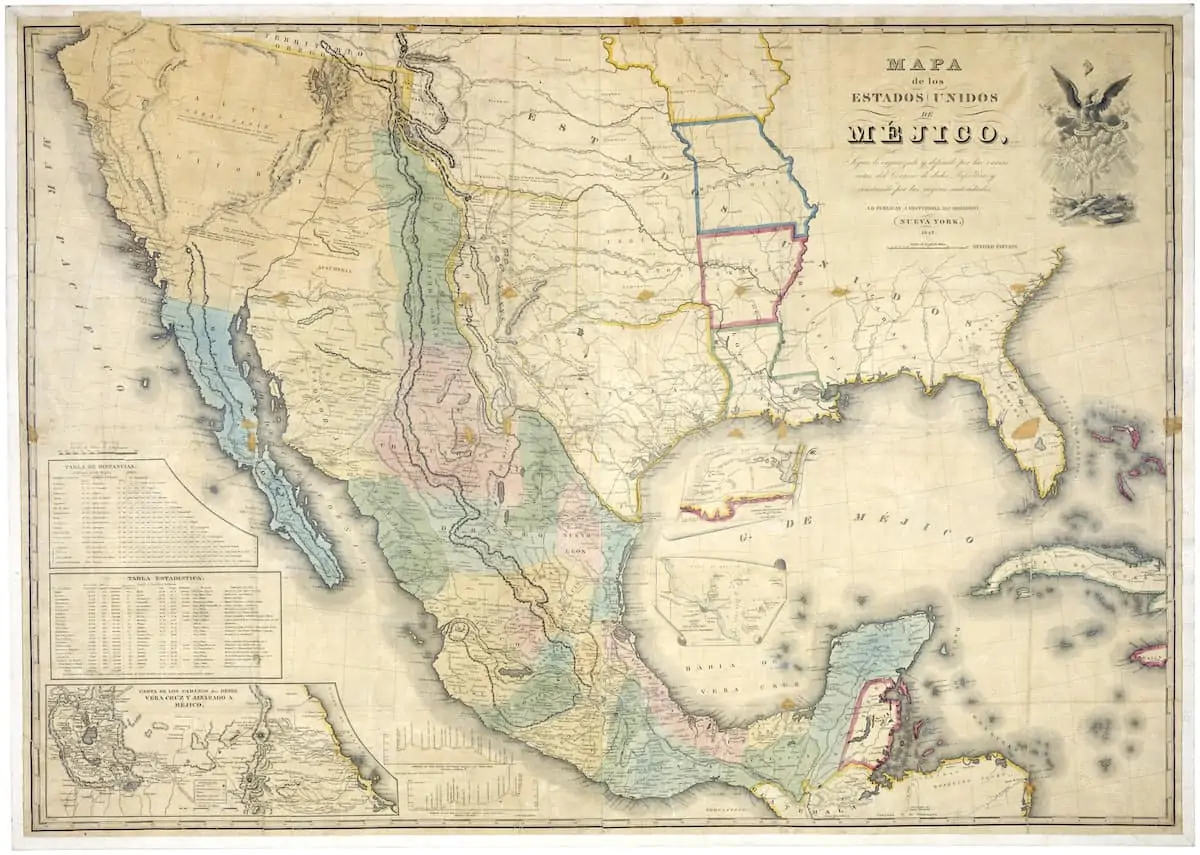
“Mapa de los Estados Unidos de Méjico” by John Disturnell, the 1847 map used during the negotiations
In return, the United States agreed to settle more than $3,000,000 in claims made by U.S. citizens against Mexico.
9. The Oregon Treaty
The original Oregon Territory, which encompasses modern-day Idaho, Oregon, Washington, Wyoming, and Montana, along with parts of British Columbia, was home to Native Americans.
It became popular due to its lucrative fur trade, and not long after, many countries wanted to claim the region for themselves. These territorial claims resulted in intense conflicts between European and American colonists.
During the late 1830s, trappers started settling down on the Oregon Territory, followed by missionaries and other settlers from different regions. With no organized government at the time, a number of settlers in the Willamette Valley came together to discuss establishing a government in the region, which led to the creation of the Provisional Government of Oregon in 1841.
As more Americans poured into the land, their territorial claims grew even more intense, to the point that the 1844 presidential campaign featured the battle cry “Fifty-four forty or fight!” (which advocated the placement of the border at 54º 40′ north latitude).
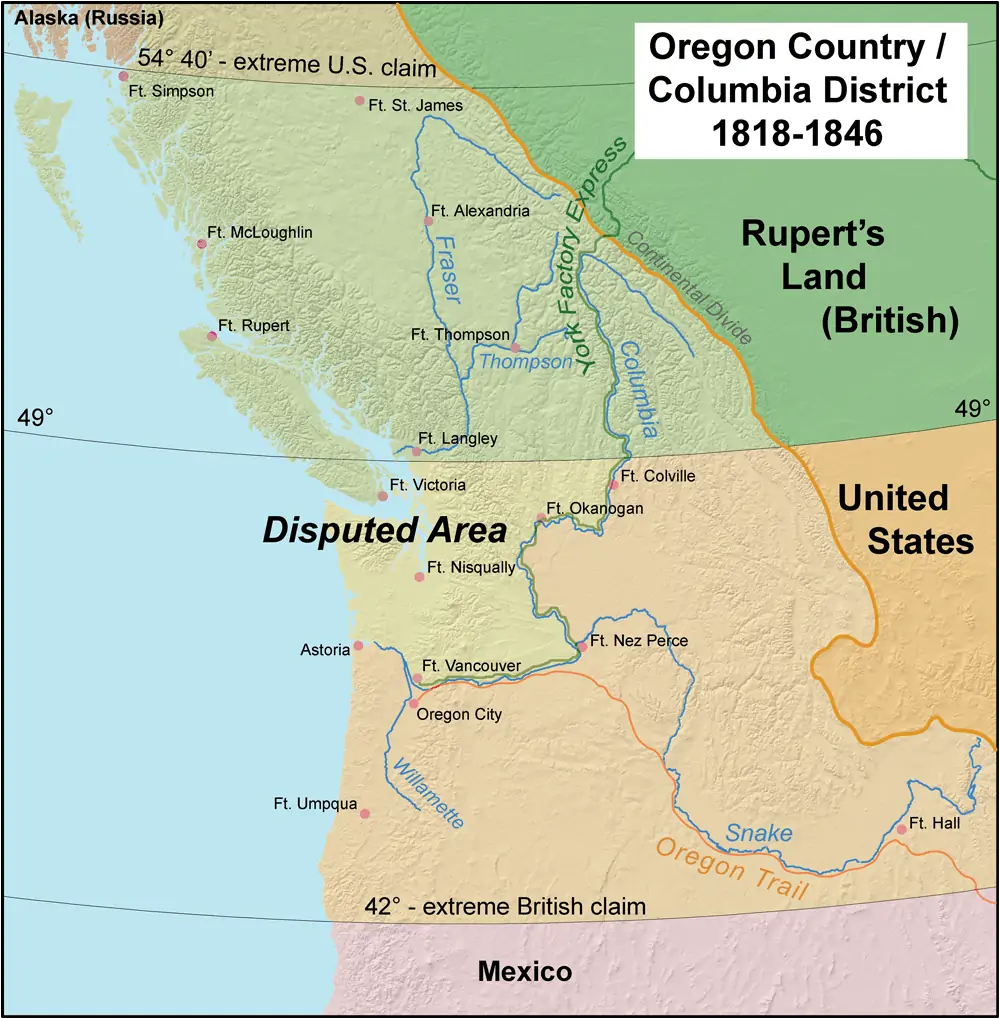
Source: Kmusser – Oregon Country and the border dispute between the U.S. and Britain, 1818-1846.
The border dispute between the United States and Britain was settled in 1846, with the signing of the Oregon Treaty. Under this agreement, the Europeans claimed the land north of the 49th parallel, including Vancouver Island, and the Americans gained the territory south of the parallel.
10. The Adams-Onis Treaty
When France sold Louisiana to the United States with the 1803 Louisiana Purchase, many Americans believed that Florida was included in the sale as part of the region.
Armed with that belief, they annexed sections of West Florida under President Thomas Jefferson’s jurisdiction. The appointment of John Quincy Adams as secretary of state in 1817 gave the United States more chances to acquire additional territory.
Between 1817 and 1818, Adams, together with newly elected President Monroe, resumed efforts to acquire Florida and a western boundary for the Louisiana Purchase. They reached an agreement with Spain after months of negotiations, and in February 1819, Adams and Don Louis de Onis, the Spanish Minister to the United States, successfully clinched the treaty.
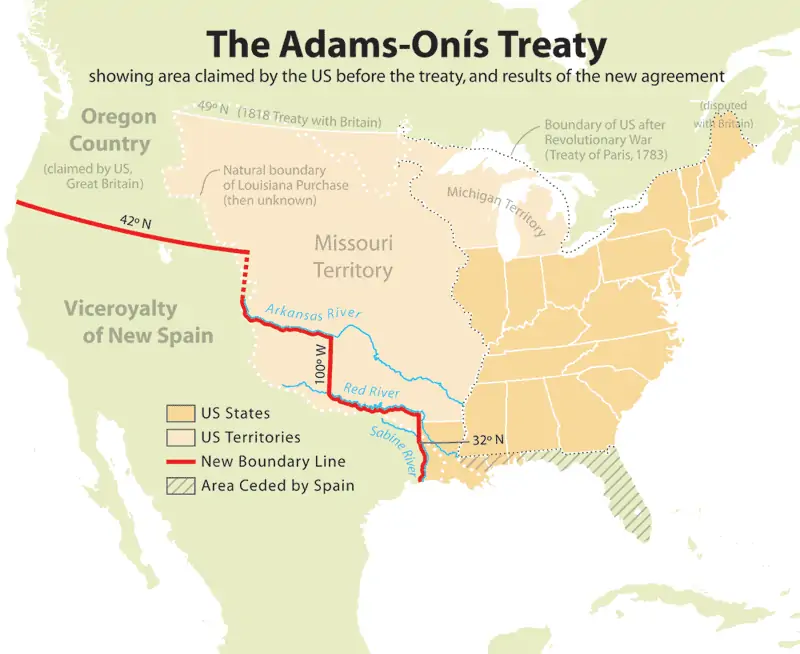
Sources: Wikipedia
By the terms of the Adams-Onis Treaty, the Americans recognized Spanish sovereignty over Texas, and Spain agreed to surrender its claim to Florida and the Northwest Territory north of 42 degrees. They also established the Sabine River as the border between the United States and their country.
11. The Gadsden Purchase
Under the Treaty of Guadalupe Hidalgo, the United States agreed to pay a hefty amount in return for the expansive land track from Texas to California.
During the negotiations, however, there was confusion among the Mexican and American representatives about the boundary line. James Gadsden, then the U.S. ambassador to Mexico, saw this as an opportunity to build an interconnected southern rail network starting from El Paso, Texas all the way to San Diego. The problem was, such a route would run through what was then Mexican territory.
He found an ally in newly elected President Franklin Pierce, who then sent him to negotiate with Mexico about the matter. Luckily for Gadsden, Mexican President Antonio Lopez de Santa Anna, who was in need of resources to rebuild his army, was a willing negotiator.
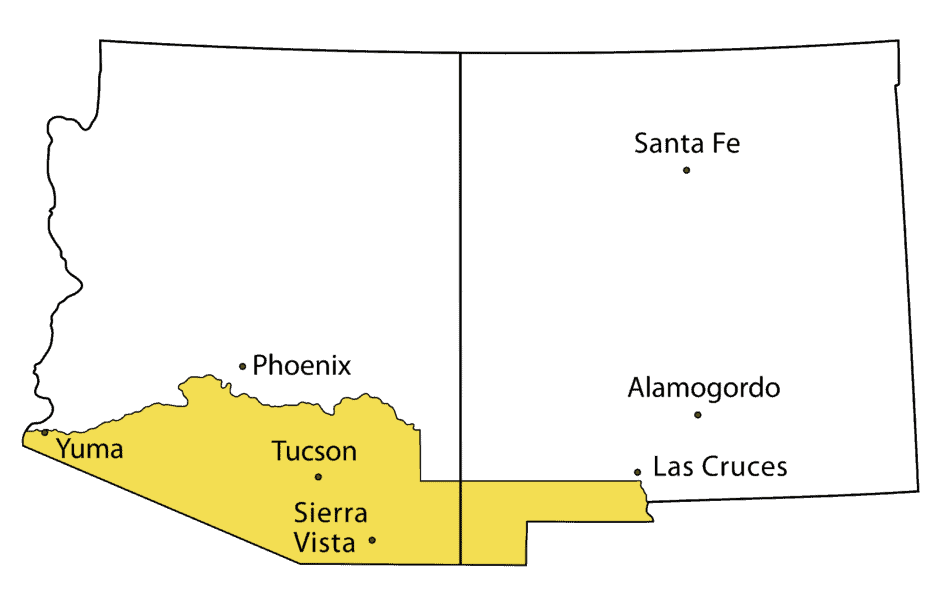
The cities included in the Gadsden Purchase (source).
In 1854, the U.S. paid $10 million dollars for the acquisition of about 30,000 square miles of land in present-day Arizona and New Mexico. Construction of the railway started almost immediately and was completed in 1881.
Sadly, Gadsden didn’t live long enough to see the railroad project completed. He died in 1858 at the age of 70.
12. Treaty of the Danish West Indies
In the 17th century, the Virgin Islands were divided between the British and the Danish, who used the region to cultivate sugarcane and brought in slaves from West Africa to work the lands.
A century later, the United States came on the scene. With its desire for territory expansion, the United States expressed interest in purchasing the Danish portion of the islands. Their efforts were in vain, though, as they were rejected twice—in 1867 (with an asking price of $7.5 million) and in 1902 (this time offering to pay only $5 million) after the acquisition of Puerto Rico.
The fear of a German takeover in 1915 pushed the United States to make another offer, and this time, they came with a more brusque tactic: if Denmark refused to sell the islands, they would instigate a military attack. Bullied by the stronger party, the Danish government negotiated a treaty with the Americans that U.S. President Wilson signed on January 16, 1917.
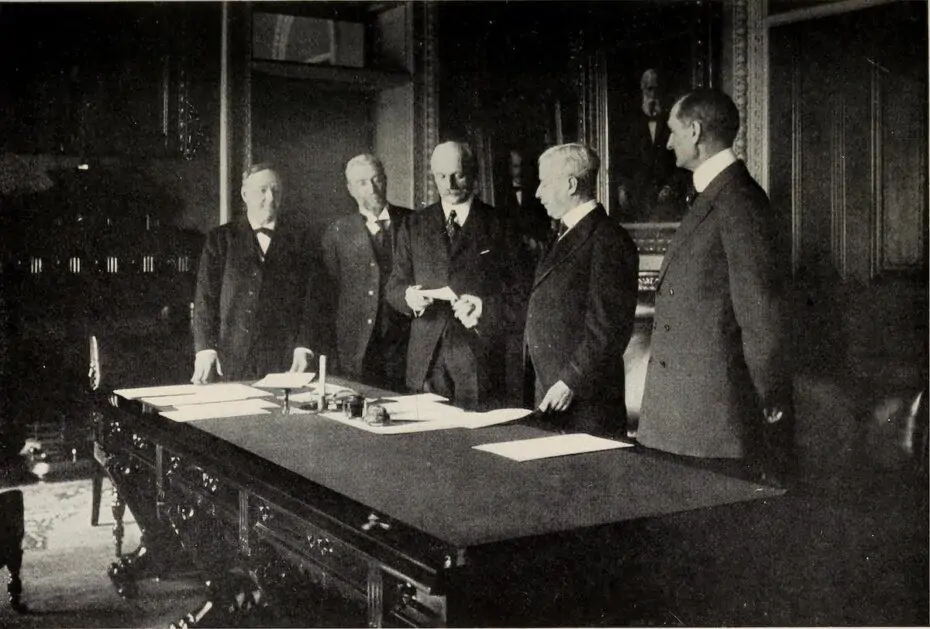
1917 money transfer after the Treaty of the Danish West Indies
Denmark officially transferred governance over the islands to the United States after getting the payment of $25 million gold coins.





